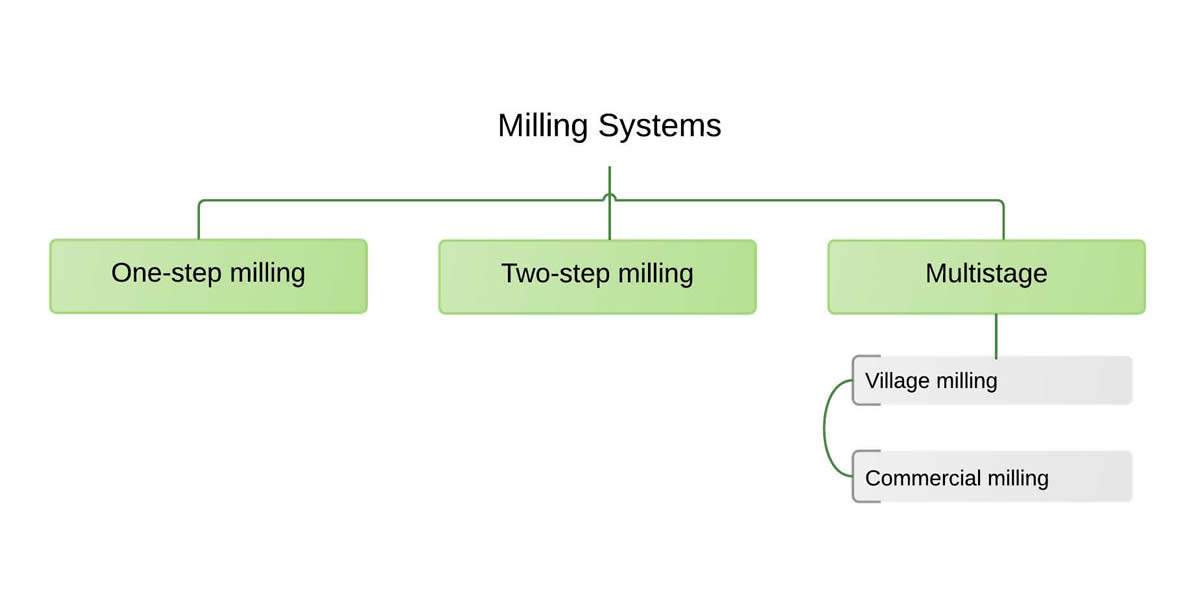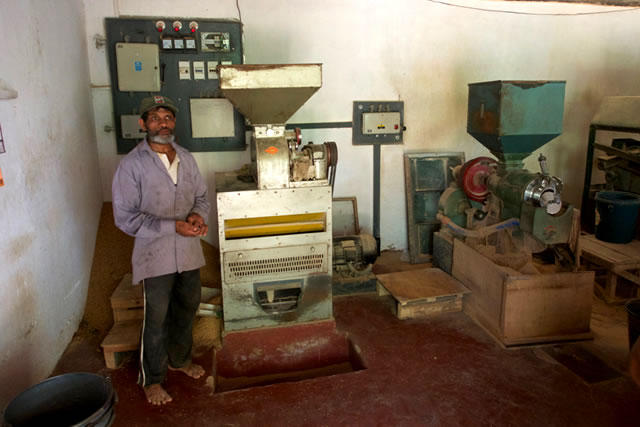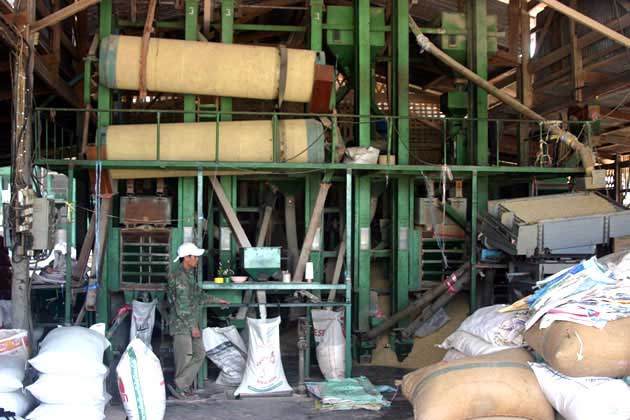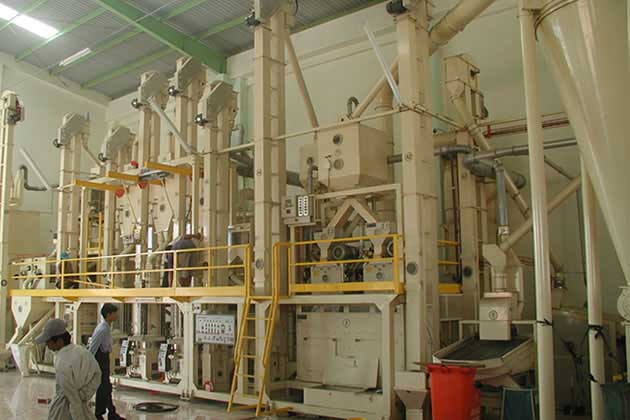Milling systems
A rice milling system can be a simple one or two step process, or a multi stage process.
- In a one step milling process, husk and bran removal are done in one pass and milled or white rice is produced directly out of paddy.
- In a two step process, removing husk and removing bran are done separately, and brown rice is produced as an intermediate product.
- In multistage milling, rice will undergo a number of different processing steps. Depending on whether the the paddy is milled in the village for local consumption or for the marketing rice milling systems can be classified into two categories: (1) village rice mills and (2) commercial mills.
Village milling
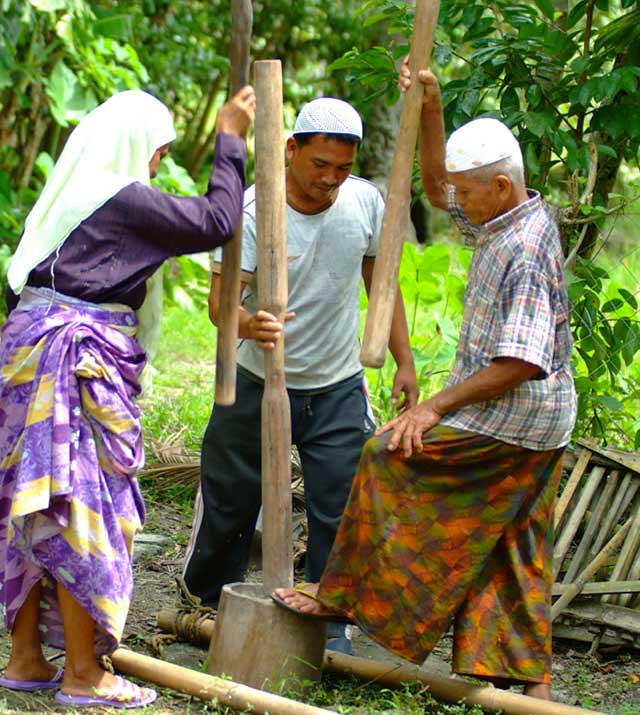 Photo: Husking with mortar and pestle
Photo: Husking with mortar and pestle
Village-type rice mills can be found in rural communities and are used for service milling paddy of farmers for home consumption.
Traditional milling
Hand pounding of paddy in a mortar with a pestle is the traditional milling process in remote villages. Pounding the paddy induces upward and downward forces on grain against grain that removes the husk and bran layers. The pounding also breaks up fissured grain. The final cleaning is by winnowing in a woven bamboo tray. The winnowing process to separate unmilled paddy grain is an art.
Village level rice mills
Village-type rice mills can be found in rural communities and are used for service milling paddy of farmers for home consumption.
Single pass, single stage mill
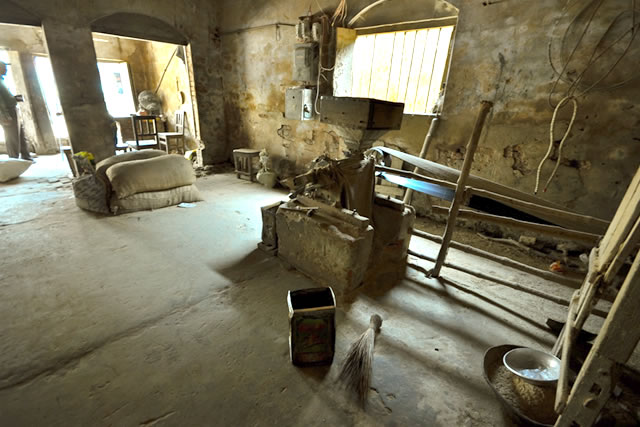 Photo: Single stage, single pass mill
Photo: Single stage, single pass mill
The single pass rice mill is an adaptation of the "Engleberg" coffee huller from the United States, modified for milling rice. In earlier days this type of rice mill was very popular in most rice-growing countries. It is still the mainstay technology for milling parboiled paddy in Bangladesh, and in many African countries. The "iron hullers", or "single pass mills" which all refer to the same mill are notorious for breaking the paddy grain. Because of the high breakage, the total milled rice recovery is 53-55%, and head rice recovery is in the order of 30% of the milled rice. The fine brokens are mixed with the bran and the ground rice hull. This by-product is used for animal feed. In many rural areas, Engleberg mills are used for custom milling the rice requirements of households. The bran produced is left to the miller as the milling fee. The poor performance of the Engleberg mill has led governments to discourage its use and has limited further proliferation. In many Asian countries, Engleberg mills can no longer be licensed to operate as service or commercial mills.
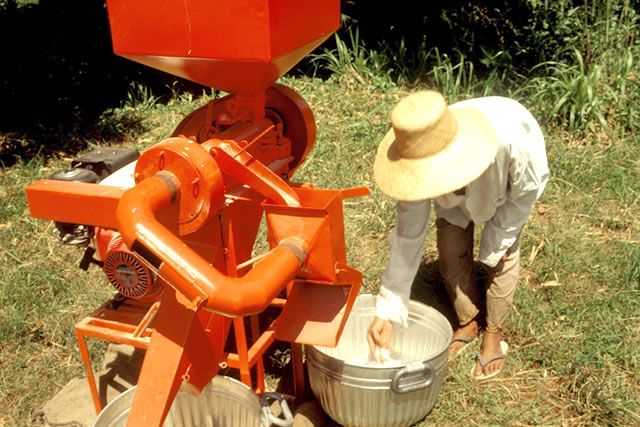 Photo: Single stage, single pass micro mill
Photo: Single stage, single pass micro mill
The Micro mill is also a single pass single stage mill, which was designed for local production. All components can be produced by local welding workshops. However, the milling recovery and head rice recovery is quite low and it is therefore only suitable for milling paddy for home consumption in very remote areas where the farmers don’t have access to a custom rice mill.
Two stage mills (single pass or two pass)
Two stage milling is either done in compact 2-stage rice mills, or with two separate machines for husking and polishing. Typically they have 0.5 to 1 ton per hour paddy input capacity. They are also used for custom milling services in the rural areas. A typical compact rice mill consists of a 6-inch diameter x 6-inch wide rubber roller husker, and a friction whitener. The friction whitener has a very similar design configuration as the Engleberg except that is has no husking knife. The milling performance of the compact rice mill is superior to the single pass Engleberg huller. Milling recoveries are normally above 60%.
Mobile rice mills
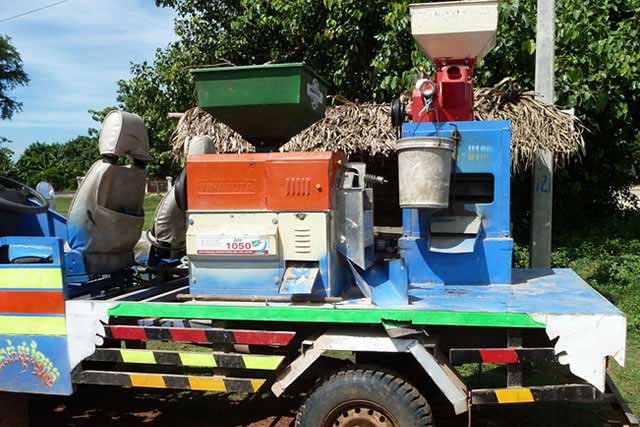 Photo: Mobile Rice Mill in Cambodia with rubber roller husker on the right and polisher on the left.
Photo: Mobile Rice Mill in Cambodia with rubber roller husker on the right and polisher on the left.
A recent development are mobile rice mills. These typically consist either of two stage, single pass mills, or alternatively a huller and a polisher mounted on a self propelled vehicle. These mobile mills can be seen in Vietnam, Cambodia, Indonesia and the Philippines. The mill comes to the customer, who does not have to transport his paddy to the mill and the milled rice back.
Commercial milling
Commercial milling systems mill the paddy in stages, and hence are called multi-stage or multi-pass rice mills. The objective of commercial rice milling is to reduce mechanical stresses and heat buildup in the grain, thereby minimizing grain breakage and producing uniformly polished grain. Compared to village-level systems, the commercial milling system is a more sophisticated system configured to maximize the process of producing well-milled, whole grains.
The rice milling facility comes in various configurations, and the milling components vary in design and performance. “Configuration” refers to how the components are sequenced. The flow diagram below shows a modern commercial mill catering to the higher end market. It has three basic stages,
- the husking stage,
- the whitening-polishing stage, and
- the grading, blending, and packaging stage.
In modern rice mills, many adjustments (e.g. rubber roll clearance, separator bed inclination, feed rates) are automated for maximum efficiency and ease of operation. The whitener-polishers are provided with gauges that sense the current load on the motor drives which gives an indication of the operating pressure on the grain. This provides a more objective means of setting milling pressures on the grain.
Objective of commercial milling
A commercial rice miller will have following objectives:
- produce edible rice that appeals to the customer - i.e. rice that is sufficiently milled and free of husks, stones, and other non-grain materials
- maximize the total milled rice recovery out of paddy and minimize grain breakage
Types of commercial mills
- Traditional commercial mill
Traditional commercial mills also consist of different pieces of equipment for the three stages outlined above. They are often made from wood with few metal components and are often driven by a single power source through a system of transmissions. Building such traditional mills was almost considered an art rather than engineering.
- Modern commercial mill
Modern commercial milling lines are fully automated and usually consist of one or more components for each stage of the milling process.
The modern rice milling process
Modern rice milling processes consist of:
| Stage | Function |
| Pre-cleaning | removing all impurities and unfilled grains from the paddy |
| Husking | removing the husk from the paddy |
| Husk aspiration | separating the husk from the brown rice/unhusked paddy |
| Paddy separation | separating the unhusked paddy from the brown rice |
| De-stoning | separating small stones from the brown rice |
| Whitening | removing all or part of the branlayer and germ from the brown rice |
| Polishing | improving the appearance of milled rice by removing remaining ran particles and by polishing the exterior of the milled kernel |
| Sifting | separating small impurities or chips from the milled rice |
| Length grading | separating small and large brokens from the head rice |
| Blending | mix head rice with predetermined amount of brokens, as required by the customer |
| Weighing and bagging | preparing milled rice for transport to the customer |
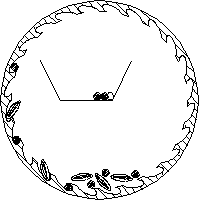
The indented sheet grader (also called trieur) is a standard piece of equipment in rice processing for length grading of milled rice.
Animation from http://www.muehle-heiligenrode.de/fmtrieur.htm
Flow diagram of a modern rice mill
The flow diagram below represents the configuration and flow in a typical modern rice mill (using the IRRI rice mill as an example).

Description of flow of materials and processes
1 – paddy is dumped in the intake pit feeding the pre-cleaner
A – straw, chaff and empty grains are removed
2 – pre-cleaned paddy moves to the rubber roll husker:
B – husk removed by the aspirator
3 – mixture of brown rice and unhusked paddy moves to the separator
4 – unhusked paddy is separated and returned to the rubber roll husker
5 – brown rice moves to the destoner
C – small stones, mudd balls etc. removed by de-stoner
6 – de-stoned, brown rice moves to the 1st stage (abrasive) whitener
7 – partially milled rice moves to the 2nd stage (friction) whitener
D – Coarse (from 1st whitener) and fine (from 2nd whitener) bran removed from the rice grainduring the whitening process
8 – milled rice moves to the sifter
E – Small brokens/brewer’s rice removed by the sifter
9a – (for simple rice mill) ungraded, milled rice moves to bagging station
9b – (for more sophisticated mill) milled rice moves to the polisher1
10 – Polished rice, will move to length grader
11 – Head rice moves to head rice bin
12 – Brokens moves to brokens bin
13 – Pre-selected amount of head rice and brokens move to blending station
14 – Custom-made blend of head rice and brokens moves to bagging station
15 – Bagged Rice moves to the market
Examples for outputs from the different stages
- Clean paddy after pre-cleaning
Paddy grain after precleaning. Poor quality grain is evident from its darker color. These are immature kernels or half filled grains that are not removed in the precleaner. The presence of poor quality grain lowers the total milling recovery.
- Brown rice at the rubber roller husker
Mixture of paddy grain and brown rice coming out of the rubber roll husker. With uniform size paddy, about 90% of the paddy should be husked after the first pass. This mixture goes through a paddy separator, after which the paddy is returned to the husker,and the brown rice goes to a de-stoner.
- Milled rice after polisher
Milled rice after the 2nd stage friction polisher. Small broken grains are still evident. This product goes to a sifter to remove the small broken grains.
Note: Most mills have several polishing stages for gentle milling. In those mills there is undermilled rice after the 1st stage friction whitener. Not all the bran layers are fully stripped. In times of rice shortage, production of undermilled rice is promoted because of the higher milling recovery.
- Brewers rice from the sifter
Brewer’s rice or small broken grains removed by the screen sifter.
